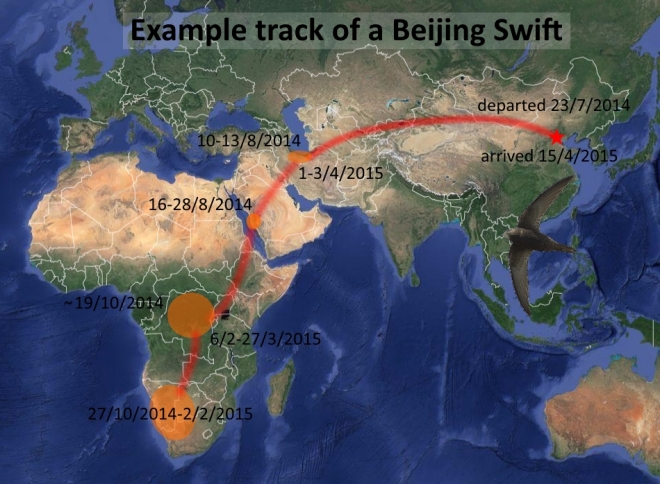 A dancing flock of starlings hypnotize us like the fire. The flock fly as a single bird; contracting and expanding, going up and then down into the trees of the avenue. The flock is clearly more than the messy sum of some hundreds of birds: it is a self-organized dynamic system showing emergent properties that escape to our comprehension.
A dancing flock of starlings hypnotize us like the fire. The flock fly as a single bird; contracting and expanding, going up and then down into the trees of the avenue. The flock is clearly more than the messy sum of some hundreds of birds: it is a self-organized dynamic system showing emergent properties that escape to our comprehension.
This is why science exists, to explain the magic trick, and enjoy nature with renewed eyes. We know from a long time ago that in a flock of starlings there isn’t a single leader governing the dance: a flock is a decentralized system where the cohesion and movement of the group is created by the massive interaction among birds.
Italian researchers have gone a step further in this explanation by taking many pictures from starling flocks flying over the city of Rome. Then, they reconstructed on the computer the 3D position of each individual inside the flock, and studied how the flight of a given bird was shaped by its neighbors. They discovered that birds aren’t affected by the position of all neighbors within a certain distance (lineal distance), but only by those six closest neighbors (topographic distance). Implementing this rule as an algorithm into a simulation model, they showed that this individual behavior enhanced the compactness of flocks when attacked by a predator. In this way, starlings evade the attack of the falcon, leaving him hypnotized by their self-organized magic.
Photo by "He and Fi" (Flickr; Creative Commons)
This post was previously published in Catalan and Spanish in this blog (see here)
Ballerini, M., Cabibbo, N., Candelier, R., Cavagna, A., Cisbani, E., Giardina, I., Lecomte, V., Orlandi, A., Parisi, G., Procaccini, A., Viale, M., & Zdravkovic, V. (2008). From the Cover: Interaction ruling animal collective behavior depends on topological rather than metric distance: Evidence from a field study Proceedings of the National Academy of Sciences, 105 (4), 1232-1237 DOI: 10.1073/pnas.0711437105











.jpg)
Seeing a flock of starlings perform this dance is wonderous and mesmerizing. I saw a flock do this when I was visiting Rome a couple of years ago. The sun was low in the sky illuminating a bank of clouds that acted as a backdrop. The beauty rivaled anything that I saw in the Vatican Musuem.
ReplyDeleteI think I can intuit this, but can you explain the difference between lineal and topographical distances? And do the six birds that are "closest" change, as the flock changes, so that it is always the six closest individuals, who ever they may be?
ReplyDeleteDear DeLene,
ReplyDeleteLineal distance is the normal euclidean distance (e.g. 20cm or 1 meter that you can measure with a ruler). As I understand it (by sure someone else can explain it better) the topographical distance can be defined in different ways. For instance, it could be defined as the difference in altitude between two points (if the two points are in a same flat surface the topographic distance is 0, although the lineal distance can be e.g. 10Km). In this paper, the authors define the topographic distance as "how many intermediate individuals separate two birds".
If I understand well the second question... yes, a flock of starlings is very dynamic, and the neighbors of one bird change rapidly. The interesting thing is that individual behavior remains the same (e.g. trying not to collide with the closest neighbors) although the identity of neighbors changes continuously.
Roger
Thank you, that does make sense. It sounds an awful lot like cycling in a racing peloton, but with the addition of altitude between the racers.
ReplyDeleteThey are fantastic birds, I live in Bretagne, France and we ( my wife & I) were sitting on our terrace one day when ( there must have been 10'000 Starlings) came in front of us and swirled & swooped for about five minutes
ReplyDeleteWe watched this today in marbury woods near northwich it went on for 30 mins was amazing! A sparrow hawk was close by too!
ReplyDeleteseen them today in chester wow wow wow must have been thousends of them they were there for 220 min then all landed in less than 5 min
ReplyDelete